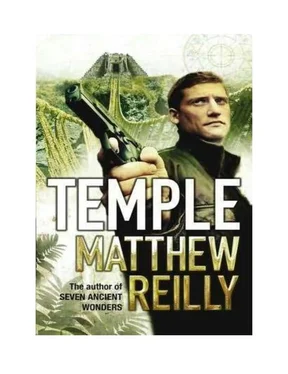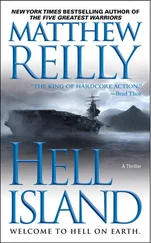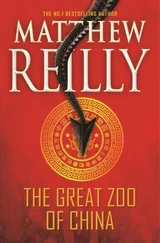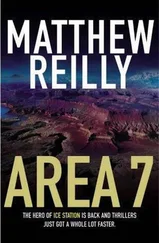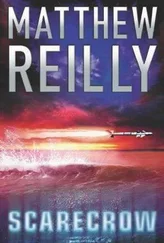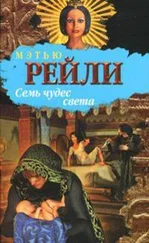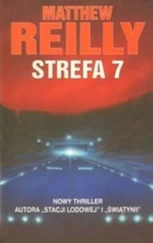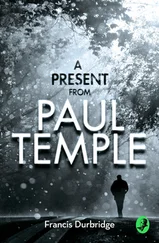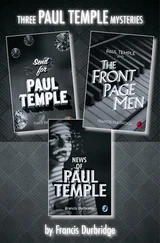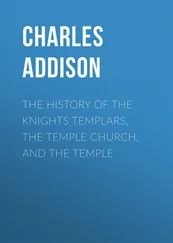‘Come on!’ Bassario cried, kicking his horse.
I spurred my own steed and shot off the mark, turning the beast sharply so that it charged toward the gate.
It was then that I turned in my saddle and saw a most amazing sight.
I saw an arrow—a pointed arrow, not a flaming one— soar across the plaza from one of the rooftops. Trailing behind it, wobbling like the undulating body of a snake, was a long length of rope—black rope the rope that had bound the row of Incan prisoners together!
The arrow shot over my head and, with a firm smacking sound, lodged in the intact upper half of the big wooden gate. No sooner had the arrow hit the gate than I saw the entire length of rope behind it go taut.
And then I saw Renco at the other end of the rope—up on one of the rooftops standing with his legs splayed wide, with his newfound satchel draped over his right shoulder— saw him lash the leather belt of his Spanish pantaloons over it, and grab hold of the belt with one hand. Then I saw him leap off the roof and swing—no, slide—down the length of the rope, over the entire plaza, hanging onto the belt with one hand.
Some Spanish soldiers opened fire on him, but the dashing young prince just used his free hand to pull his pistol from his waistband and fire it at them while he slid at incredible speed down the rope!
I spurred my steed on, increased her speed, and pulled her in at a full gallop under Renco’s rope just as he reached the end of his slide. He released his grip on the belt and dropped down perfectly onto the rump of my horse.
In front of us, Bassario leapt like a seasoned horseman through the enormous hole in the wooden gate. Renco and I followed close behind him, riding double, vaulting through the gate amid a hail of wild gunshots.
We burst out into the cold night air—riding hard across the massive stone slab that formed a bridge over the city’s northern moat—and the first thing I heard as I raced across that bridge was a roar of total and utter jubilation from the hoards of Incan warriors in the valley before me.
‘How’s it going?’ a voice said suddenly.
Race glanced up from the manuscript and for a moment was disoriented. He looked out through the small window to his right and saw a sea of snowcapped mountains and an endless expanse of clear blue sky.
He shook his head. He’d been so absorbed in the story that he’d forgotten he was on board the Army cargo plane.
Troy Copeland stood in front of him. He was one of Nash’s DARPA people, the hawk-faced nuclear physicist.
‘So, how’s it going?’ Copeland said, nodding at the bundle of paper in Race’s lap. ‘Found the location of the idol yet?’
‘Well, I’ve found the idol,’ Race said, flipping through the remainder of the manuscript. He was about two-thirds of the way through it. ‘I think I’m about to find out where they took it.’
‘Good,’ Copeland said, turning. ‘Keep us posted.’
‘Hey’ Race said. ‘Before you go, can I ask you something?’
‘Sure.’
‘What is thyrium261 used for?’
Copeland frowned at the question.
‘I think I have a right to know,’ Race said.
Copeland nodded slowly. ‘Yes… yes, I guess you do.’ He took a breath. ‘As I think you were told before, thyrium261 is not indigenous to Earth. It comes from a binary star system called the Pleiades, a system not far from our own.
‘Now, as you can probably imagine, planets in binary star systems are affected by all sorts of forces because of their twin suns—photosynthesis is doubled; gravitational effects, as well as resistance to gravity, are enormous. As such, elements found on planets in binary systems are usually heavier and denser than similar elements found here on Earth. Thyrium261 is just such an element.
‘It was first found in petrified form in the walls of a meteor crater in Arizona in 1972. And even though the specimen there had been inert for millions of years, its potential sent shockwaves throughout the physics community.’
‘Why?’
‘Well, you see, on a molecular level, thyrium bears a striking resemblance to the terrestrial elements uranium and plutonium. But thyrium outweighs both of these earthly elements by an order of magnitude. It is denser than our two most potent nuclear elements combined. Which means it is infinitely more powerful.’
Race began to feel a sense of dread crawling up his spine.
Where was Copeland going with this?
‘But like I said, thyrium has only ever been found on Earth in petrified form. Since 1972, two other samples have been discovered, but again both of those specimens were at least 40 million years old. Which is of no use to anyone since petrified thyrium is inert, chemically dead.
“What we have been waiting for for the past twenty-seven years is the discovery of a specimen of “live” thyrium, a specimen that is still active on a molecular level. And now we think we’ve found it, in a meteorite that crash-landed in the jungles of Peru five hundred years ago.’
‘So what does thyrium do?’ Race asked.
‘A lot,’ Copeland said. ‘A whole lot. For one thing, its potential as a power source is astronomical. Conservative estimates predict that a properly constituted thyrium reactor would generate electrical energy at a rate six hundred times greater than all the nuclear power plants in the United States combined.
‘But there’s an added bonus. Unlike our terrestrial nuclear elements, when thyrium is used as the core element of a fusion reactor, it decomposes with one hundred per cent efficiency. In other words, it leaves no contaminated waste byproducts. As such, it is unlike any power source on this earth. Uranium waste must be discarded in radioactive rods. Hell, even gasoline produces carbon monoxide. But thyrium is clean. It is a perfectly efficient power source.
Perfect. It is so internally pure that, based on our modeling, a raw sample of it would emit only microscopic quantities of passive radiation.’
Race held up his hand. ‘All right, all right. That all sounds great, but last I heard, DARPA wasn’t in the business of providing America with power stations. What else does thyrium do?’
Copeland smiled, caught.
‘Professor, for the last ten years, DARPA’s Tactical Technology Office has been working on a new weapon, a weapon unlike anything this world has ever seen. It is a device code-named “Supernova”.’
As soon as Copeland said the word, something twigged in the back of Race’s mind. He recalled a conversation he’d overheard between Copeland and Nash soon after he had boarded the plane. A conversation in which they had mentioned a breakin at Fairfax Drive and the theft of a device called a Supernova.
‘What exactly is this Supernova?’
‘Put simply,’ Copeland said, ‘the Supernova is the most powerful weapon ever devised in the history of mankind.
It’s what we call a planet killer.’
‘A what?
‘A planet killer. A nuclear device so powerful that when detonated, it would completely destroy nearly a third of the Earth’s mass. With a third of its mass gone, the Earth’s orbit around the sun would be corrupted. Our planet would spin out of control, out into space, further and further away from the sun. Within minutes the Earth’s surface—what was left of it—would be too cold to sustain human life. The Super nova, Professor Race, is the first manmade device that is capable of ending life as we know it on this planet. Hence its namesake, the name we give to an exploding star.’
Race swallowed. In fact, he felt positively weak.
A million questions flooded his mind.
Like, why would someone build such a device? What possible reason could there be for creating a weapon that could kill everyone on the planet, including its own creators? And all that considered, why was his country building it?
Читать дальше
